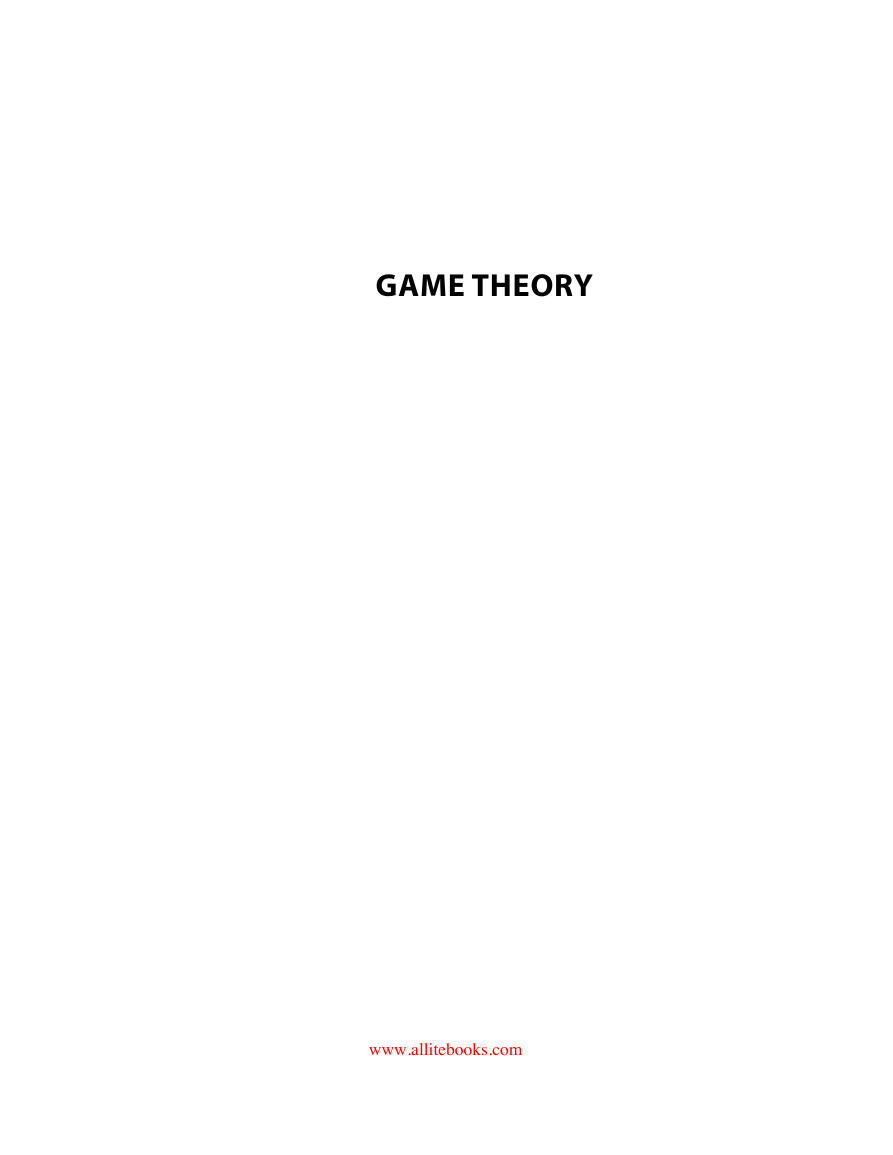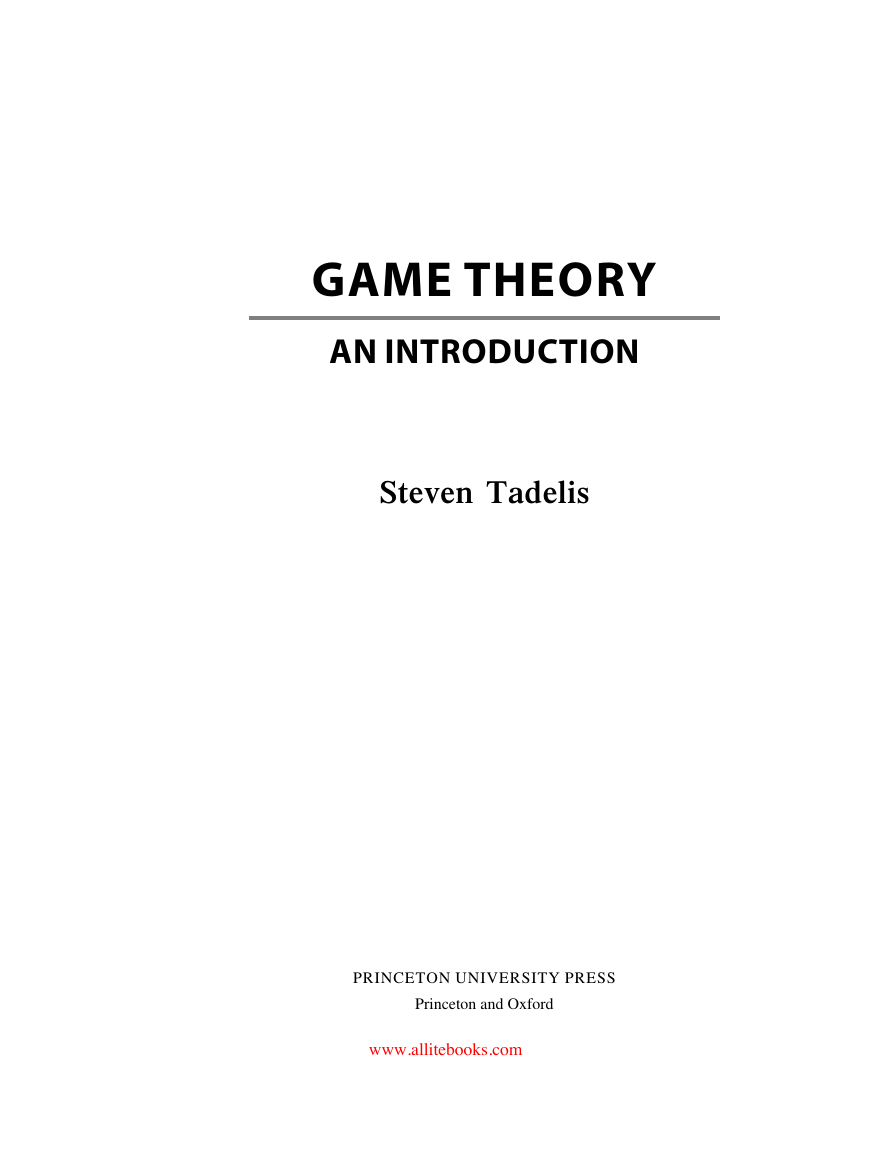Cover
GAME THEORY
Title
Copyright
Contents
Preface
PART I Rational Decision Making
Chapter 1 The Single-Person Decision Problem
1.1 Actions, Outcomes, and Preferences
1.1.1 Preference Relations
1.1.2 Payoff Functions
1.2 The Rational Choice Paradigm
1.4 Exercises
1.3 Summary
Chapter 2 Introducing Uncertainty and Time
2.1 Risk, Nature, and Random Outcomes
2.1.1 Finite Outcomes and Simple Lotteries
2.1.2 Simple versus Compound Lotteries
2.1.3 Lotteries over Continuous Outcomes
2.2 Evaluating Random Outcomes
2.2.1 Expected Payoff: The Finite Case
2.2.2 Expected Payoff: The Continuous Case
2.2.3 Caveat: It’s Not Just the Order Anymore
2.2.4 Risk Attitudes
2.2.5 The St. Petersburg Paradox
2.3 Rational Decision Making with Uncertainty
2.3.1 Rationality Revisited
2.3.2 Maximizing Expected Payoffs
2.4 Decisions over Time
2.4.1 Backward Induction
2.4.2 Discounting Future Payoffs
2.5 Applications
2.5.1 The Value of Information
2.5.2 Discounted Future Consumption
2.6 Theory versus Practice
2.7 Summary
2.8 Exercises
PART II Static Games of Complete Information
Chapter 3 Preliminaries
3.1 Normal-Form Games with Pure Strategies
3.1.1 Example: The Prisoner’s Dilemma
3.1.2 Example: Cournot Duopoly
3.1.3 Example: Voting on a New Agenda
3.2 Matrix Representation: Two-Player Finite Game
3.2.1 Example: The Prisoner’s Dilemma
3.2.2 Example: Rock-Paper-Scissors
3.3 Solution Concepts
3.3.1 Assumptions and Setup
3.3.2 Evaluating Solution Concepts
3.3.3 Evaluating Outcomes
3.4 Summary
3.5 Exercises
Chapter 4 Rationality and Common Knowledge
4.1 Dominance in Pure Strategies
4.1.1 Dominated Strategies
4.1.2 Dominant Strategy Equilibrium
4.1.3 Evaluating Dominant Strategy Equilibrium
4.2 Iterated Elimination of Strictly Dominated Pure Strategies
4.2.1 Iterated Elimination and Common Knowledge of Rationality
4.2.2 Example: Cournot Duopoly
4.2.3 Evaluating IESDS
4.3 Beliefs, Best Response, and Rationalizability
4.3.1 The Best Response
4.3.2 Beliefs and Best-Response Correspondences
4.3.3 Rationalizability
4.3.4 The Cournot Duopoly Revisited
4.3.5 The “p-Beauty Contest”
4.3.6 Evaluating Rationalizability
4.4 Summary
4.5 Exercises
Chapter 5 Pinning Down Beliefs: Nash Equilibrium
5.1 Nash Equilibrium in Pure Strategies
5.1.1 Pure-Strategy Nash Equilibrium in a Matrix
5.1.2 Evaluating the Nash Equilibria Solution
5.2 Nash Equilibrium: Some Classic Applications
5.2.1 Two Kinds of Societies
5.2.2 The Tragedy of the Commons
5.2.3 Cournot Duopoly
5.2.4 Bertrand Duopoly
5.2.5 Political Ideology and Electoral Competition
5.3 Summary
5.4 Exercises
Chapter 6 Mixed Strategies
6.1 Strategies, Beliefs, and Expected Payoffs
6.1.1 Finite Strategy Sets
6.1.2 Continuous Strategy Sets
6.1.3 Beliefs and Mixed Strategies
6.1.4 Expected Payoffs
6.2 Mixed-Strategy Nash Equilibrium
6.2.1 Example: Matching Pennies
6.2.2 Example: Rock-Paper-Scissors
6.2.3 Multiple Equilibria: Pure and Mixed
6.3 IESDS and Rationalizability Revisited
6.4 Nash’s Existence Theorem
6.5 Summary
6.6 Exercises
PART III Dynamic Games of Complete Information
Chapter 7 Preliminaries
7.1 The Extensive-Form Game
7.1.1 Game Trees
7.1.2 Imperfect versus Perfect Information
7.2 Strategies and Nash Equilibrium
7.2.1 Pure Strategies
7.2.2 Mixed versus Behavioral Strategies
7.2.3 Normal-Form Representation of Extensive-Form Games
7.3 Nash Equilibrium and Paths of Play
7.4 Summary
7.5 Exercises
Chapter 8 Credibility and Sequential Rationality
8.1 Sequential Rationality and Backward Induction
8.2 Subgame-Perfect Nash Equilibrium: Concept
8.3 Subgame-Perfect Nash Equilibrium: Examples
8.3.1 The Centipede Game
8.3.2 Stackelberg Competition
8.3.3 Mutually Assured Destruction
8.3.4 Time-Inconsistent Preferences
8.4 Summary
8.5 Exercises
Chapter 9 Multistage Games
9.1 Preliminaries
9.2 Payoffs
9.3 Strategies and Conditional Play
9.4 Subgame-Perfect Equilibria
9.5 The One-Stage Deviation Principle
9.6 Summary
9.7 Exercises
Chapter 10 Repeated Games
10.1 Finitely Repeated Games
10.2 Infinitely Repeated Games
10.2.1 Payoffs
10.2.2 Strategies
10.3 Subgame-Perfect Equilibria
10.4 Application: Tacit Collusion
10.5 Sequential Interaction and Reputation
10.5.1 Cooperation as Reputation
10.5.2 Third-Party Institutions as Reputation Mechanisms
10.5.3 Reputation Transfers without Third Parties
10.6 The Folk Theorem: Almost Anything Goes
10.7 Summary
10.8 Exercises
Chapter 11 Strategic Bargaining
11.1 One Round of Bargaining: The Ultimatum Game
11.2 Finitely Many Rounds of Bargaining
11.3 The Infinite-Horizon Game
11.4 Application: Legislative Bargaining
11.4.1 Closed-Rule Bargaining
11.4.2 Open-Rule Bargaining
11.5 Summary
11.6 Exercises
PART IV Static Games of Incomplete Information
Chapter 12 Bayesian Games
12.1 Strategic Representation of Bayesian Games
12.1.1 Players, Actions, Information, and Preferences
12.1.2 Deriving Posteriors from a Common Prior: A Player’s Beliefs
12.1.3 Strategies and Bayesian Nash Equilibrium
12.2 Examples
12.2.1 Teenagers and the Game of Chicken
12.2.2 Study Groups
12.3 Inefficient Trade and Adverse Selection
12.4 Committee Voting
12.5 Mixed Strategies Revisited: Harsanyi’s Interpretation
12.6 Summary
12.7 Exercises
Chapter 13 Auctions and Competitive Bidding
13.1 Independent Private Values
13.1.1 Second-Price Sealed-Bid Auctions
13.1.2 English Auctions
13.1.3 First-Price Sealed-Bid and Dutch Auctions
13.1.4 Revenue Equivalence
13.2 Common Values and the Winner’s Curse
13.3 Summary
13.4 Exercises
Chapter 14 Mechanism Design
14.1 Setup: Mechanisms as Bayesian Games
14.1.1 The Players
14.1.2 The Mechanism Designer
14.1.3 The Mechanism Game
14.2 The Revelation Principle
14.3 Dominant Strategies and Vickrey-Clarke-Groves Mechanisms
14.3.1 Dominant Strategy Implementation
14.3.2 Vickrey-Clarke-Groves Mechanisms
14.4 Summary
14.5 Exercises
PART V Dynamic Games of Incomplete Information
Chapter 15 Sequential Rationality with Incomplete Information
15.1 The Problem with Subgame Perfection
15.2 Perfect Bayesian Equilibrium
15.3 Sequential Equilibrium
15.4 Summary
15.5 Exercises
Chapter 16 Signaling Games
16.1 Education Signaling: The MBA Game
16.2 Limit Pricing and Entry Deterrence
16.2.1 Separating Equilibria
16.2.2 Pooling Equilibria
16.3 Refinements of Perfect Bayesian Equilibrium in Signaling Games
16.4 Summary
16.5 Exercises
Chapter 17 Building a Reputation
17.1 Cooperation in a Finitely Repeated Prisoner’s Dilemma
17.2 Driving a Tough Bargain
17.3 A Reputation for Being “Nice”
17.4 Summary
17.5 Exercises
Chapter 18 Information Transmission and Cheap Talk
18.1 Information Transmission: A Finite Example
18.2 Information Transmission: The Continuous Case
18.3 Application: Information and Legislative Organization
18.4 Summary
18.5 Exercises
Chapter 19 Mathematical Appendix
19.1 Sets and Sequences
19.1.1 Basic Definitions
19.1.2 Basic Set Operations
19.2 Functions
19.2.1 Basic Definitions
19.2.2 Continuity
19.3 Calculus and Optimization
19.3.1 Basic Definitions
19.3.2 Differentiation and Optimization
19.3.3 Integration
19.4 Probability and Random Variables
19.4.1 Basic Definitions
19.4.2 Cumulative Distribution and Density Functions
19.4.3 Independence, Conditional Probability, and Bayes’ Rule
19.4.4 Expected Values
References
Index
















 2023年江西萍乡中考道德与法治真题及答案.doc
2023年江西萍乡中考道德与法治真题及答案.doc 2012年重庆南川中考生物真题及答案.doc
2012年重庆南川中考生物真题及答案.doc 2013年江西师范大学地理学综合及文艺理论基础考研真题.doc
2013年江西师范大学地理学综合及文艺理论基础考研真题.doc 2020年四川甘孜小升初语文真题及答案I卷.doc
2020年四川甘孜小升初语文真题及答案I卷.doc 2020年注册岩土工程师专业基础考试真题及答案.doc
2020年注册岩土工程师专业基础考试真题及答案.doc 2023-2024学年福建省厦门市九年级上学期数学月考试题及答案.doc
2023-2024学年福建省厦门市九年级上学期数学月考试题及答案.doc 2021-2022学年辽宁省沈阳市大东区九年级上学期语文期末试题及答案.doc
2021-2022学年辽宁省沈阳市大东区九年级上学期语文期末试题及答案.doc 2022-2023学年北京东城区初三第一学期物理期末试卷及答案.doc
2022-2023学年北京东城区初三第一学期物理期末试卷及答案.doc 2018上半年江西教师资格初中地理学科知识与教学能力真题及答案.doc
2018上半年江西教师资格初中地理学科知识与教学能力真题及答案.doc 2012年河北国家公务员申论考试真题及答案-省级.doc
2012年河北国家公务员申论考试真题及答案-省级.doc 2020-2021学年江苏省扬州市江都区邵樊片九年级上学期数学第一次质量检测试题及答案.doc
2020-2021学年江苏省扬州市江都区邵樊片九年级上学期数学第一次质量检测试题及答案.doc 2022下半年黑龙江教师资格证中学综合素质真题及答案.doc
2022下半年黑龙江教师资格证中学综合素质真题及答案.doc